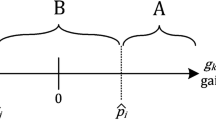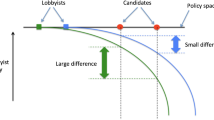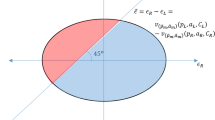Abstract
This essay develops a simple model to analyze the impact of campaign contributions on electoral-policy decisions of candidates for office. Interest groups here are firms that select contributions under the assumption that candidates' policies and opposing groups' donations remain unaltered. Candidates, however, recognize that their policy choices affect contributions. Campaign contributions are used by candidates to affect policy-oriented voters' perceptions of candidates' positions. In this framework the introduction of campaign contributions may affect candidates' electoral policies, and if they do then they benefit surely exactly one of the two interest groups.
Similar content being viewed by others
References
Adamany, D. (1977). Money, politics and democracy: A review article. American Political Science Review 71: 289–304.
Aranson, P., and Hinich, M. (1979). Some aspects of the political economy of election campaign laws. Public Choice 34: 435–461.
Aranson, P., Hinich, M., and Ordeshook, P. (1974). Election goals and strategies: Equivalent and nonequivalent strategies. American Political Science Review 68: 135–152.
Austen-Smith, D. (1981). Party policy and campaign costs in a multi-constituency model of electoral competition. Public Choice 37:389–402.
Ben-Zion, U., and Eytan, Z. (1974). On money, votes and policy in a democratic society. Public Choice 17: 1–10.
Brock, W., and Magee, S. (1978). The economics of special interest groups: The case of the tariff. American Economic Review 68: 246–250.
Calvert, R. (1986). Models of imperfect information in politics. Mimeo. Washington University, St. Louis (forthcoming in Fundamentals of Pure and Applied Economics).
Chamberlin, J. (1978). A collective goods model of pluralist political systems. Public Choice 33: 97–113.
Coughlin, P. (1983). Pareto optimality of policy proposals with probabilistic voting. Public Choice 39: 427–434.
Coughlin, P. (1984). Probabilistic voting. In S. Kotz, N. Johnson and C. Read, Encyclopedia of Statistical Sciences. Vol. 6. New York: Wiley.
Drew, E. (1982). Politics and money. New Yorker, 6 and 13 December.
Enelow, J., and Hinich, M. (1984). The Spatial Theory of Voting. Cambridge: Cambridge University Press.
Friedman, J. (1977). Oligopoly and the Theory of Games. Amsterdam: North-Holland.
Hinich, M. (1977). Equilibrium in spatial voting: The median voter is an artifact. Journal of Economic Theory 16: 208–219.
Hinich, M. (1978). The mean vs. the median in spatial voting games. In P. Ordeshook (Ed.), Game Theory and Political Science. New York: New York University Press.
Hinich, M., Ledyard, P., and Ordeshook, P. (1972). Nonvoting and the existence of equilibrium under majority rule. Journal of Economic Theory 14: 144–153.
Jacobson, G. (1980). Money in Congressional Elections. New Haven: Yale University Press.
Peltzman, S. (1976). Toward a more general theory of regulation. Journal of Law and Economics 18: 211–240.
Shepsle, K. (1972). The strategy of ambiguity: Uncertainty and electoral competition. American Political Science Review 66: 555–568.
Welch, W. (1974). The economics of campaign funds. Public Choice 20: 83–92.
Welch, W. (1980). The allocation of political monies: Economic interest groups. Public Choice 35: 97–120.
Author information
Authors and Affiliations
Additional information
An earlier version of this essay (titled ‘Interest Groups, Campaign Contributions and Spatial Voting’) was written while I was a Postdoctoral Fellow in Political Economy at GSIA, Carnegie-Mellon University, Pittsburgh, PA. I am grateful to John Bone, Tom Palfrey, Tom Romer, two anonymous referees, and Peter Aranson for helping me clarify some of the issues here. They bear no responsibility for any remaining muddles, however.
Rights and permissions
About this article
Cite this article
Austen-Smith, D. Interest groups, campaign contributions, and probabilistic voting. Public Choice 54, 123–139 (1987). https://doi.org/10.1007/BF00123002
Issue Date:
DOI: https://doi.org/10.1007/BF00123002




